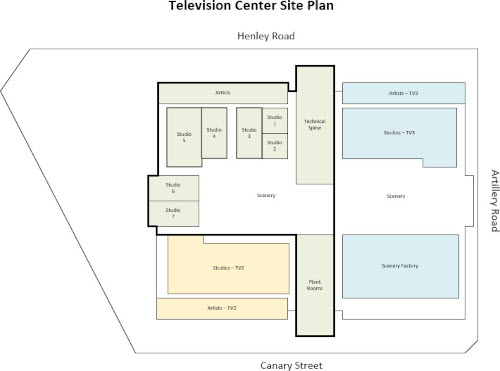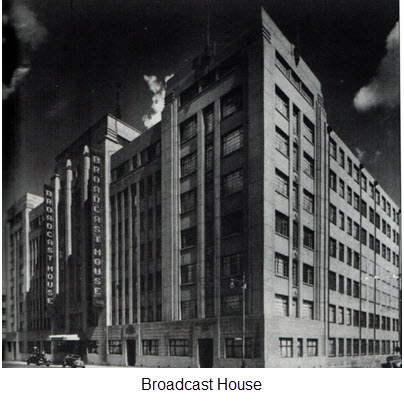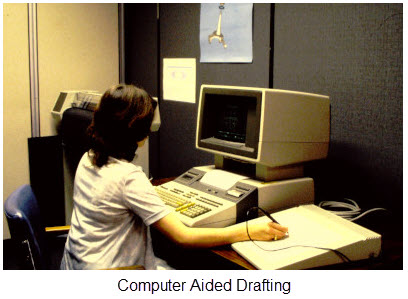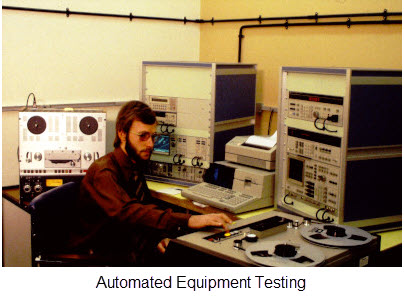TV2/3 Project
1979 to 1982
Broadcast House
After the introduction of the English/Afrikaans based television service (TV1) in 1976, the planned Bantu language television services (TV2/3) were placed on hold. The plans for these services did not fit the apartheid policy of the government at that time. The SABC finally found a way to address the issues and gave the go ahead for the project in 1979.
Brian Horn (SABC - 1971 to 1989)
When the SABC implemented their TV project in 1970 it consisted of three phases, namely TV1, TV2 and TV3. Fischbach and Moore were appointed as the consultants to design and build the Television Center in Auckland Park. The first phase, TV1, was completed when it commenced service on January 6, 1976.

The Television Center Site Plan shows the planned three phases. TV2 and TV3 were the planned TV services serving the Bantu (black) population.
On completion of phase 1 the SABC terminated their contract with Fischbach & Moore, the reason reportedly being that they could not afford the costs of the future phases. How much did cancelling the contract cost the SABC?
The reason, however, was a lot more complex. In the 1970’s South Africa was strictly enforcing apartheid and the government was firmly in the hands of the Afrikaner Broederbond (Brotherhood). Not only was the Television Center located in Auckland Park, but just a few blocks away was the headquarters of the Afrikaner Broederbond (AB) and the Rand Afrikaans University. There was no way the AB controlled SABC was going to proceed with phases 2 (TV2) and 3 (TV3) as it would mean daily bussing hundreds of Bantu into the AB controlled white area of Auckland Park.
At the other SABC Auckland Park site, the adjacent block to the north of the Television Center, a Radio Center studio complex, 28 floor office building, workshops, central stores, and underground parking were being constructed. The complex know as Broadcasting Center was officially opened by Dr. P. J Meyer on April 6, 1976. Dr. Meyer was Chairman of the SABC Board and had been Chairman of the AB from 1960 to 1972.
With the completion of the Radio Center the radio studios on Commissioner Street, in the city center, were closed and their activities transferred to the new facilities in Auckland Park.
The Commissioner Street facilities remained vacant for years, that is until management decided to gut the building and convert it into studios and facilities for TV2/3.
I was informed of the decision in 1979, the goal was to launch the new services on January 1, 1982.
I was asked to come up with a preliminary design, equipment procurement and installation schedule. I submitted this report “Y7001” to management, it addressed the schedule for the tender (RFP) specification release, order placement and required delivery for the 45 categories of equipment required. I was also asked to submit a proposal for the staffing of the design team I was to lead, August Breedt was to head the installation project team. The proposed project team consisted of 15 people.

- Principal Engineer - Brian Horn
- Senior Engineer: Video Systems + Engineer
- Senior Engineer: Audio Systems - Gert Krige + Engineer
- Senior Engineer: Control Systems - Brian Gould + Engineer
- Senior Engineer: Installation Support + 3 Design Draftsmen
- Engineer: Film Systems
This position was never filled as the TV2/3 system design completely eliminated the use of film. Any incoming film material to be used in a television production or language dubbing was transferred to videotape at the Television Center at Auckland Park. - Typist - Lorraine Smit
- Equipment Control/Engineering Assistants - Alan Maree and Dave Brooks
I spent six weeks in the USA in 1979 visiting equipment vendors, attending Ampex VPR-2 training and subsequent VPR-2 acceptance testing. The potential equipment suppliers visited in the USA were CMC, Farinon, CVS, Recortec, Grass Valley Group, Spin Physics and Dynair. A further overseas trip in February 1980 included visits to Magnatech, RCA, Vital Industries, MCI, CVS, CMX Systems, Arvin/Echo, EECO, Grass Valley Group, Ampex, and Datatron in the USA and Studer/Revox in Switzerland.
We had another project running during this same period, it was the introduction of ENG (Electronic News Gathering). Up to this time all TV news had been shot using 16mm film cameras, the film stock being processed in the film processing facilities in the basement of TVC. It was then edited and sent to telecine for inclusion in the news bulletins. This was a time-consuming process, making the meeting of deadlines very difficult. ENG used RCA TK-76 video cameras with NEC video recorders, tapes were rushed back to the news department at TVC, where they were quickly edited and given to the Studio 1 news team for broadcast, a much quicker process.
The introduction of ENG created some obstacles and some interesting moments:
- The news teams were not happy with the idea of carrying a video camera which weighed more than their film cameras. Never mind the portable VTR. Their solution if I could do it for a day, they would. So, I was assigned to a news team for a day, they were right it was hard work. On one assignment we went to a work site where some workers were protesting. On arrival the reporter was promptly taken away by the police. When he returned, he advised us we had to leave and could not cover the event. When I told him we had shot footage while he was away, he advised me we had to destroy it as it could not be used.
- After ENG was introduced, I gave a presentation to the Engineers Association of South Africa at a luncheon at the Johannesburg station. I was accompanied by my team consisting of Theuns Nel, Alan Arthurs and Wickus van den Meulen. On the way back to TVC after the presentation I drove through a traffic light which turned red while I was in the intersection. I was pulled over by a motorcycle police officer. Wickus got out of the car and told me he would take care of it. He went and spoke to the officer who got back on his motorcycle and promptly rode off. When I asked Wickus how he taken care of it he showed us his BOSS (Bureau of State Security) identity card. He was an undercover agent, and they had more power than a police officer.
The TV1 system design was based on centralized facilities such as video/audio switching, communications, VTR and telecine. This design meant that the central facilities had to be commissioned before any of the studios could be commissioned. It was expensive both in terms of equipment and staffing. For example, the video/audio/control switcher supplied by EMI was custom and the largest they had supplied at the time.
Analyzing what had been done on the TV1 project we took a completely different approach based on creating self-contained studios. All rack mounted equipment, that is for the cameras, audio, video, lighting and control we located in the engineering control room, including an Ampex VPR-2 video tape recorder. The only connections to the TV main control area were communications and video and audio tielines. Separate video tape editing suites were provided for postproduction usage. The TV2/3 complex was linked to the TV1 complex where the TV2/3 final control room was located.
 Although a staffing structure had been submitted and approved, it was extremely difficult to find the needed personnel and significant challenges were faced with respect to:
Although a staffing structure had been submitted and approved, it was extremely difficult to find the needed personnel and significant challenges were faced with respect to:
- Technical Drafting
Head Offices Studios, of which were part, had a team of three draftsmen, Bruce Dames, Dick Hart and Peter Koziel. Two additional people, Stella Hart and Julie Botha were hired to support the additional TV2/3 project workload. All drawings were done using ink on vellum, this required any corrections or changes to be made by scratching off the area not required any redrawing it in ink. If a similar drawing was required, such as the video wiring for a different studio, a vellum copy could be made, but the changes then required extensive erasing and redrawing.
The decision was made to investigate CAD (Computer Aided Drafting) which had been introduced by several companies including IBM. After analysis of the systems available it was decided to implement a locally developed solution by Skok Systems, which utilized HP workstation computer system. Drawings could be rapidly drawn, corrections easily made, variations of designs created and then drawings plotted on drawing paper to be used for reproduction.
The decision was not readily accepted by the drawing office team, who saw it as a threat to their jobs. Their answer was to assign the junior member of their team, Julie Botha, to learn the new system with the hope that it would fail. The systems were a great success yielding productivity increases of 3:1 to 4:1. CAD grew to be a section under Julie Botha, consisting of 31 computer systems at three sites, meeting the needs of broadcast, electrical and mechanical engineering, including the TV1 set design team.
A paper on Engineering Office Automation3 was presented at a HP conference in Warwick, UK in 1985. - Equipment Acceptance Testing
Acceptance testing of incoming equipment created it own challenges due to the volume of equipment and the project deadlines. This crisis was overcome by the implantation of automated audio and video testing. With no such systems available one was developed based on HP 9826 desktop computers, HP, and Tektronix instrumentation. A paper on the system was presented at the International Broadcasting Convention1 in Brighton, UK in September 1982.
One example of the system was its ability to do complete testing of a Dynair 1000 cross-point audio/video switcher. A device which at that time had only been able to be tested on a random cross-point basis, even by the manufacturer.
Some of the equipment acceptance testing was done at the manufacturers facilities. One such item was the vision mixer/computer system to be used in the TV2/3 FCC (Final Control Center). The contract for this system was awarded to Vital Industries in Gainsville, Florida. During the aceptance testing it became obvious that the team we were doing the testing with were concerned about something. One of the feature requirements was the handling of a power outage, so just before lunch I pulled the power cord, disconnecting the system, creating an unforseen power outage. The result was not good and even by end of day they had not managed to get the system to recover. At a meeting the next morning the Vital management team they admitted the power failure issue was a known concern they had not been able to resolve at that stage. I contacted Phil Bartel, to whom I reported back at the SABC, that evening and updated him on the situation requesting authority to cancel the contact if the issue was not resolved the following day. The set back was significant because of the long lead times for such equipment and the tight project deadlines. The contract was cancelled and I proceeded to negotiate with Len Dole at the Grass Valley Group to supply the FCC system.

A design challenge that had to be resolved was how to handle “Language Dubbing”. This was the process where television material was purchased from Europe, or the USA and the language track was dubbed into one of the local languages. 50% of the material broadcast on the TV1 network was in Afrikaans, a large percentage of that consisting of television series whose soundtrack had be dubbed to Afrikaans. The TV1 process was film based, the purchased material being 16mm film. The dubbing process consisted of creating a script for the actors to read from as the film was viewed. A separate 16mm magnetic film was used to record the newly created audio track. The process was known as “rock and roll” as the three machines were synchronized and repeated the play and record process until a new lip synchronized recording was made. This complex process required extensive film editing, band writing and viewing facilities.
It was decided that rather than repeat this process we decided to design a video-based language dubbing system. There we no such systems in use and so we developed a specification and put it out to tender (RFP) for several systems. The contract was awarded to United Media Inc in Anaheim, CA. A paper on the system design and implementation was given at the International Broadcasting Convention2 in September 1982 in Brighton UK.
The TV2/3 project required an enormous effort by the design and installation teams led by Brian Horn and August Breedt, but these achieved their goals enabling the two new television services to commence their services on January 1, 1982.
References:
- “Automatic Broadcast Equipment Test System” – International Broadcasting Convention, Brighton, UK - September 1982 - B.V. Horn and T.J. Nel
- “Language Dubbing – A Video Based System” – International Broadcasting Convention, Brighton, UK - September 1982 - IBC September 1982, - B.V. Horn and C.E.F. Ferreira
- “Engineering Office Automation” – HP Users Conference, Warwick, UK – July 1985 – Brian V. Horn